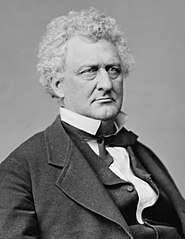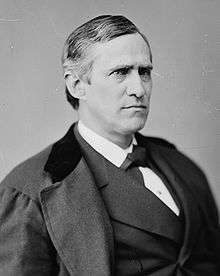1876 Democratic National Convention
The 1876 Democratic National Convention assembled in St. Louis just nine days after the conclusion of the Republican National Convention in Cincinnati.
| 1876 presidential election | |
  Nominees Tilden and Hendricks | |
| Convention | |
|---|---|
| Date(s) | June 27–29, 1876 |
| City | St. Louis, Missouri |
| Venue | Merchants Exchange Building |
| Candidates | |
| Presidential nominee | Samuel Tilden of New York |
| Vice presidential nominee | Thomas Hendricks of Indiana |
This was the first political convention held west of the Mississippi River. St. Louis was notified in February 1876 that it had been selected. Among the events was a fireworks display from the top of the Old Courthouse.
Proceedings
The convention was called to order by Democratic National Committee chairman Augustus Schell. Henry Watterson served as the temporary convention chairman and John Alexander McClernand, a retired congressman and major general, served as permanent convention president.
Platform
The Democratic platform pledged to replace the corruption of the Grant administration with honest, efficient government and to end "the rapacity of carpetbag tyrannies" in the South; called for treaty protection for naturalized U.S. citizens visiting their homeland, restrictions on Oriental immigration, and tariff reform; and opposed land grants to railroads.[1]
Presidential nomination
Presidential candidates


 Major General Winfield Scott Hancock of Pennsylvania
Major General Winfield Scott Hancock of Pennsylvania Former Governor William Allen of Ohio
Former Governor William Allen of Ohio

.jpg)
The 12th Democratic National Convention assembled in St. Louis in June 1876. Five thousand people jammed the auditorium in St. Louis, hoping for the Democrats' first presidential victory in 20 years. The platform called for immediate and sweeping reforms following the scandal-plagued Grant administration.
Six names were placed in nomination: Samuel J. Tilden, Thomas A. Hendricks, Winfield Scott Hancock, William Allen, Thomas F. Bayard, and Joel Parker. Tilden won more than 400 votes on the first ballot and the nomination by a landslide on the second. Although Tilden was strongly opposed by "Honest John" Kelly, the leader of New York's Tammany Hall, he was still able to obtain the nomination. It is claimed that Tilden's nomination was received by the voting Democrats with more enthusiasm than any leader since Andrew Jackson.[2]
| Presidential Ballot | ||||||
| 1st Before Shifts | 1st After Shifts | 2nd Before Shifts | 2nd After Shifts | Unanimous | ||
|---|---|---|---|---|---|---|
| Samuel J. Tilden | 400.5 | 416.5 | 535 | 517 | 738 | |
| Thomas A. Hendricks | 139.5 | 139.5 | 85 | 87 | ||
| Winfield Scott Hancock | 75 | 75 | 58 | 58 | ||
| William Allen | 54 | 54 | 54 | 54 | ||
| Thomas F. Bayard | 33 | 33 | 4 | 4 | ||
| Joel Parker | 18 | 18 | 0 | 18 | ||
| James Broadhead | 16 | 0 | 0 | 0 | ||
| Allen G. Thurman | 2 | 2 | 2 | 0 | ||
Source: Official proceedings of the National Democratic convention, held in St. Louis, Mo., June 27th, 28th and 29th, 1876. (September 3, 2012).

1st Presidential Ballot
Before Shifts
1st Presidential Ballot
After Shifts
2nd Presidential Ballot
Before Shifts
2nd Presidential Ballot
After Shifts
Vice Presidential nomination
Vice Presidential candidate
Thomas Hendricks was the only individual nominated for vice-president, and received the nomination almost unanimously on the first ballot. The delegation from Ohio had thought of offering the name of one of her distinguished sons, Henry B. Payne. However, the feeling of unanimity was so great that the Ohio delegation declined to present his name and seconded the nomination of Hendricks. But when the roll call vote took place, Ohio cast 8 blank ballots.
| Vice Presidential Ballot | |
| 1st | |
|---|---|
| Thomas A. Hendricks | 730 |
| Blank | 8 |
Source: Official proceedings of the National Democratic convention, held in St. Louis, Mo., June 27th, 28th and 29th, 1876. (September 3, 2012).

1st Vice Presidential Ballot
See also
- 1876 Republican National Convention
- List of Democratic National Conventions
- U.S. presidential nomination convention
- 1876 United States presidential election
- History of the United States Democratic Party
References
- William DeGregorio, The Complete Book of U.S. Presidents, Gramercy 1997
- They Also Ran
Further reading
External links
- Democratic Party Platform of 1876 at The American Presidency Project
- Official proceedings of the National Democratic convention, held in St. Louis, Mo., June 27th, 28th and 29th, 1876
| Preceded by 1872 Baltimore, Maryland |
Democratic National Conventions | Succeeded by 1880 Cincinnati, Ohio |
